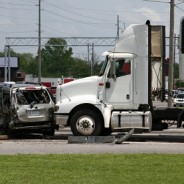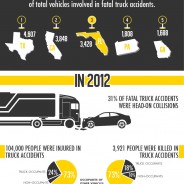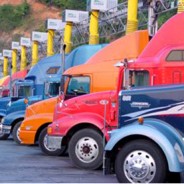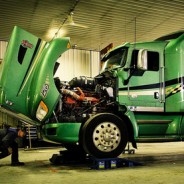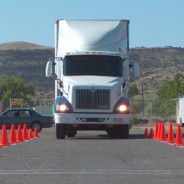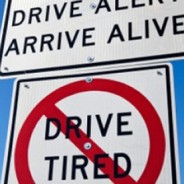Blog
The Aftermath: What to Expect After a Truck Accident
In the aftermath of a truck accident, victims are often uncertain about the future and what steps to take. In many cases, truck accident injuries cause victims to lose wages and spend money on medical treatment. Victims are typically under a lot of stress, both from these financial pressures and from spending time and energy on treatment and recovery. Contacting an attorney can help victims understand what to expect after a truck accident, and start down the road to recovering compensation. Contacting a Truck Accident Attorney An experienced truck accident attorney is knowledgeable about the different laws surrounding truck accidents, and will be able to provide victims with case-specific advice. Most truck accident lawsuits are filed against the company that hired the truck driver. In many cases, these companies are large corporations with extensive resources to defend their case. An attorney is helpful in handling claims against large corporations by helping provide clients with the resources needed to file against corporations. There may also be statute of limitations laws that come into play, limiting the amount of time that a victim has to file a lawsuit against the trucking company. An attorney can help to gather the evidence and file a claim within the necessary time frame for the particular jurisdiction in which the accident occurred. Truck Accident Lawsuits Due to the weight and size of tractor trailers, truck accidents often cause severe injuries. After treating injuries, claims will usually be filed against the victim’s health insurance and PIP insurance, if applicable. However, these types of insurance usually do not completely cover the cost of treatment needed for injuries such as head trauma, paralysis, and spinal cord damage. To recover additional compensation for treatment, a truck accident attorney may have to negotiate with insurance companies or file a lawsuit against the trucking company. Negligence Lawsuits Most truck accident lawsuits are based on proving the truck driver or company’s negligence. Negligent actions that may cause a truck accident include failing to obey traffic laws, failing to stop at weigh stations, overloading the vehicle, and driving for longer than is legally allowed without taking a break. Product Liability Lawsuits If a truck accident was caused by a flaw or malfunction of the truck or a truck part, a product liability lawsuit may be filed against the manufacturer of the truck or part. These types of lawsuits may be more difficult to prove, and often require the testimony of an expert. An attorney will be invaluable in acquiring the evidence necessary to file this type of claim, as the burden of proving that the truck or part was unreasonably dangerous even when the truck was being operated and maintained as intended will fall on the plaintiff. Sources: http://www.dmv.org/fl-florida/accident-guide/...
read moreTruck Accidents vs. Car Accidents
Truck accidents are similar to car accidents in that the two types of accidents may cause injuries and damage. Truck accident lawsuits and car accident lawsuits both attempt to recover compensation for victims that have been injured or killed through personal injury or wrongful death lawsuits. However, truck accidents differ from car accidents in many important ways. When pursuing a lawsuit following a trucking accident, victims may benefit greatly from hiring a lawyer than has experience with truck accident lawsuits. Differences in Accident Severity Trucks generally weigh about 25 times as much cars. This disparity in weight makes the likelihood of severe injuries or fatalities much higher in a truck accident than in a car accident. Truck accidents may also damage several vehicles or cause multiple collisions. In addition to the dangers posed by the size and weight of the truck, the severity of truck accidents can be worsened by freight spills. Differences in Accident Details According to the National Highway Traffic Safety Administration, approximately 50 times the number of people were injured or killed in car accidents than truck accidents in 2011. Approximately 24 percent of car accident fatalities involved alcohol as a factor, compared with one percent of truck accident fatalities. Differences in Risk Factors The size and proportions of large trucks alter the risk factors inherent in driving a truck versus a car. Risk factors for truck drivers include large blind spots, dangers associated with taking sharp turns, and dangers associated with freight balancing on hills. A trucking company may also be held liable for a driver’s inability to properly anticipate and respond to these risk factors, which would not be a consideration in a car accident. Truck drivers must also be aware of the risk factors and regulations associated with driving for many hours in succession, which is also not a consideration in car accident lawsuits. Differences in Lawsuits While both truck accident victims and car accident victims must prove negligence when pursuing legal action, the type of negligence may be very different. Car accident victims must prove the negligence of the car driver or a faulty vehicle manufacturer through the use of documentation such as an accident report. Truck accident victims may need to prove the negligence of the trucking company, the driver, the vehicle manufacturer, or even the manufacturer of the cargo. Acquiring the evidence necessary to successfully prosecute a trucking company can become much more complicated than prosecuting a car driver. Sources: “Highway Safety Information System: An Examination of Fault, Unsafe Driving Acts, and Total Harm in Car-Truck Collisions.” U.S. Department of Transportation Federal Highway Administration. U.S. Department of Transportation, 12 Apr. 2012. Web. 13 Sept. 2014. <http://www.fhwa.dot.gov/publications/research/safety/humanfac/04085/> “Quick Facts 2011.” National Highway Traffic Safety Administration. National Highway Traffic Safety Administration, 1 Apr. 2013. Web. 13 Sept. 2014. <http://www-nrd.nhtsa.dot.gov/Pubs/811760QF.PDF> “Relative Contribution/Fault in Car-Truck Crashes.” American Trucking Association. American Trucking Association, 1 Feb. 2013. Web. 13 Sept. 2014. <http://www.truckline.com/ATA Docs/News and Information/Reports Trends and Statistics/02 12 13 — FINAL 2013 Car-Truck Fault...
read moreMAP-21 Legislation Overview
MAP-21 is the Moving Ahead for Progress in the 21st Century Act which was signed into law by President Obama in July of 2012. The Act was set up to reform funding and authorization for federal surface transportation spending in order to promote growth and development of the country’s roadways and transportation systems. $105 billion was allocated to be spent over the fiscal years 2013 and 2014, with the Act going into effect on October 1, 2012 and expiring on October 1, 2014. Goals of MAP-21 The main goals of MAP-21 are to build needed bridges, roads, and transit systems and to reduce the number of crashes, injuries, and fatalities occurring on roadways. The Act also creates many jobs as a bi-product of these goals. The Act contains many statutes regulating commercial vehicle and driver standards to increase safety on roads throughout the United States. The Act also consolidates highway and transit programs to eliminate outdated or duplicate programs. MAP-21 Legislation MAP-21 implementation is guided by a series of legislation reforms and programs. These programs attempt to address challenges in the current transportation system. The legislation also addresses funding for needed projects and accountability of progress for programs instituted under the act. Highway Improvements MAP-21 seeks to improve the highways of America by strengthening the systems which are currently in place to maintain and upgrade the most important highways. MAP-21 also includes detailed plans to incorporate major roadways which were not previously connected to main thoroughfares. In order to eliminate confusion and streamline processes, the existing highway transportation programs have been revised down to a few core programs. Safety Improvements MAP-21 provides additional support for the existing Highway Safety Improvement Program that is enforced by the Department of Transportation. The funding for infrastructure safety was doubled under MAP-21. The program builds on safety efforts such as the fight against distracted driving. Performance Based Programs The programs implemented under MAP-21 will be reviewed for performance. The information acquired will be used to discern the most efficient use of funds. This type of firm performance management will help to reduce unnecessary spending while maximizing results. MAP-21 Program Funding Funding for MAP-21 is generated without an increase in user fees. MAP-21 outlines how funds will be generated and how they will be distributed. Funds will be generated by implementing certain measures which will save the Department of Transportation money, changing pension plan interest rates, and allowing federal employees to enter into phased retirement. Funds will be distributed to each state based on calculations of the lump sum for each new program divided proportionally. Sources: “H.R.4348 — MAP-21 (Enrolled Bill [Final as Passed Both House and Senate] – ENR).” The Library of Congress. The Library of Congress. Web. 13 Sept. 2014. <http://thomas.loc.gov/cgi-bin/query/z?c112:h.r.4348.enr:> “MAP-21 – Moving Ahead for Progress in the 21st Century Act.” Federal Motor Carrier Safety Administration. U.S. Department of Transportation, 17 Apr. 2014. Web. 12 Sept. 2014. < http://www.fmcsa.dot.gov/mission/policy/map-21-moving-ahead-progress-21st-century-act> “Status of Major FHWA Activities to Implement MAP-21.” U.S. Department of Transportation Federal Highway Administration. U.S. Department of Transportation, 21 Oct. 2013. Web. 12 Sept. 2014....
read moreTruck Accident Dangers Infographic
Use the code below to embed infographic <a href="https://truckaccidentsupport.com" target="_blank"><img src="https://truckaccidentsupport.com/wp-content/uploads/2015/03/Truck-Accident-Dangers-Infographic.jpg" alt="Truck Accident Dangers" style="width:100%;"...
read moreWhat To Do after a Truck Accident
Truck accidents kill and injure many Americans each year due to the large size and weight of the vehicle. Tractor trailers trucks are also more susceptible to certain risk factors due to the weight distribution when carrying cargo. In 2012, roughly 3,921 people were killed in large truck accidents, and another 104,000 people were injured. About 73 percent of fatalities and injuries were occupants of other vehicles at the time of the truck accident. Since so many truck accidents affect other drivers, it is important that passengers and drivers understand what actions should be taken immediately following a truck accident. Truck Accident Scene At the truck accident scene, it is vital that certain steps be taken. Immediately after the accident, emergency services should be contacted. This will help to establish the degree and severity of the accident, and will help to control dangerous situations. Victims should receive needed medical attention before other actions are taken. Waiting for Emergency Services While waiting for emergency personnel, those that are uninjured may help by blocking victims from further dangers, such as oncoming traffic. It may also be necessary to move vehicles that present hazards. Victims should not be moved accept by medical personnel, as injuries may be worsened. Flares or hazard lights may help to warn other drivers of the accident. Gathering Information When dangers are under control and victims have been tended to, it is important to obtain as much evidence as possible pertaining to the details of the crash. Writing down recollections and witness accounts can help to preserve the information before it is forgotten. Taking pictures of damage and injuries as soon as possible can help to prove many aspects of a case. In some cases, video recording may provide new insights into a crash. Victims should also obtain a copy of the police report and any relevant medical records for future reference. Contacting a Truck Accident Attorney After a truck accident, victims are often in shock. Contacting a lawyer as soon as possible may help truck accident victims follow procedures that will help later when trying to recover compensation. An experienced truck accident attorney can provide advice about how to compile evidence and what not to say to insurance companies or law enforcement. An attorney may even be able to come to the crash scene in order to assist with gathering evidence, taking photographs, and speaking with emergency personnel and insurance agents. Sources: http://www.dmvflorida.org/car-accident.shtml http://www-nrd.nhtsa.dot.gov/Pubs/811868.pdf...
read moreEvolution of Highway Truck Stops
Highway truck stops have come a long way since their debut in the 1940s. When they were first implemented, they were simply a place for trucks to refill their gas tanks before heading back onto the road. The trucking industry has experienced tremendous growth since the 1940s. The changing needs of the trucking industry are reflected in the 21st century truck stop. In comparison to these original stops, today’s truck stop is highly evolved. Some even include special features and luxury amenities that rival a spa or resort. Trucking Industry Growth Upon examining the incredible growth of the trucking industry in the past decades, the specialized nature of today’s truck stops comes as no surprise. According to the American Trucking Association (ATA), trucks transport roughly 70 percent of all freight in the United States each year. Trucks are the sole delivery source for more than 80 percent of America’s communities. The success of the trucking industry means that there are many trucks delivering many goods around the country, and that means there are many truckers who are spending most of their lives on the road. Special Amenities A wide selection of food is one of the staples of today’s truck stop. Patrons can often choose from several types of food, from snacks to full meals. A number of truck stops also feature brand-name restaurants. Today’s truck stop may also feature amenities like showers, Internet kiosks, and wireless access. Truck stops are evolving away from the quick stop-and-go image they were built on. Instead, these facilities are encouraging drivers to enjoy a home away from home. Some truck stops even feature special activities and amenities, such as: Rooms for overnight stay Gyms and fitness classes Jacuzzis Hair salons and spas Movie theaters Bowling alleys Health checkups Chiropractic services Servicing the Public When truck stops were originally developed, they were solely intended to service truck drivers. However, with the evolution of the truck stop has come an evolution in the type of patrons who come and go. More and more of the general traveling public have begun to frequent truck stops to take advantage of the broad food selections and special amenities. In order to support the image of being open to the public, many truck stops have been coined as “travel plazas” or “travel centers.” Truck stops have also begun to boast “family friendly” features to encourage families to take a break during road trips and other...
read moreSummer Trucking Preparations
While it is common knowledge that trucks must be prepared for cold weather and poor conditions, it is equally important that trucks be prepared for the heat of summer. High temperatures can put strain on the mechanical components, and hot asphalt can increase the risks of blowouts and tire damage. To prevent mechanical failures and costly repairs, it is important to properly prepare trucks prior to summer usage. Summer Trucking Maintenance Preparations To ensure that the tires are safe for use in hot conditions, the tire pressure should be checked when temperatures begin to rise, and on a regular basis throughout the summer. Tires typically lose about one psi per month, but may lose more when temperatures shift dramatically. Underinflated tires have a higher chance of catastrophic blowouts, especially if the outside temperature exceeds 90 degrees. Underinflated and overinflated tires also decrease fuel efficiency and wear out faster. Mechanical Systems Prior to operating a truck during the summer, it is important that all fluids be topped off and all systems receive proper maintenance. Belts should be checked and replaced as needed, and any recommended maintenance based on mileage should be completed. Air conditioning should be inspected prior to the season to ensure functionality, as a failed air conditioning unit can pose health risks for the driver. Refrigerated Trucks High temperatures put additional strain on refrigeration units, so it is imperative to test cooled compartments regularly and perform maintenance as needed. Refrigeration failures during the heat of summer can be costly for trucking companies, both in terms of repairs and damaged shipments. Refrigeration failures can also impact customer relations when deliveries fail to be delivered on time and in good condition. Summer Trucking Cleaning Preparations Removing leftover residues from winter sand and salt can help to improve the efficiency of vehicles and prevent costly corrosion repairs down the road. When cleaning trucks in preparation for the summer, it is important to ensure that hidden places on the truck are cleaned as well as the outside. The radiator, undercarriage, and other hard to reach areas may harbor sand and chemical build-ups that can damage systems. Driver Summer Preparations Truck drivers should also be sure to properly prepare for summer by staying hydrated and taking precautions. Drivers that are exposed to the sun for long periods of time when making deliveries should wear protective clothing and sunscreen. Drivers should also be sure to rest in cooled areas when necessary to prevent against heat stroke. Truck drivers that are operating while overheated or dehydrated not only put themselves and the delivery in danger, but also pose a risk to other drivers. Sources: http://www.consumerreports.org/cro/news/2012/08/tips-to-keep-your-car-tires-cool-amid-damaging-summer-heat/index.htm http://www.dmvflorida.org/tires-heat.shtml...
read moreCommercial Driver License
Under federal law, a commercial driver license (CDL) is required for those who wish to operate vehicles weighing 26,000 pounds or more for commercial use. Other requirements for a commercial driver license include transportation of hazardous materials regulated by the Department of Transportation, as well as vehicles designed for 16 or more passengers. These requirements went into effect under the Commercial Motor Vehicle Safety Act of 1986. Commercial Driver License Skills Those who drive commercial vehicles must have a higher level of experience, knowledge, physical abilities, and skills than those who drive non-commercial vehicles. Due to the inherently dangerous and challenging nature of driving a commercial vehicle, these drivers are held to higher standards. If drivers commit serious traffic violations, their commercial driver license eligibility may be affected. Applicants must pass knowledge and skills testing in order to receive a commercial driver license. Licensing by State The process and requirements for obtaining a commercial driver license will typically vary by state. The Federal Motor Carrier Safety Administration’s (FMCSA) CDL Division oversees this process across states and sets standards that apply to commercial drivers. The FMCSA CDL Division is responsible for the creation and maintenance of special policies, guidelines, and procedures that create a foundation for each state’s program. While each state’s specific regulations may vary, they must all comply with the federal standards expected of each state. Commercial Driver License Testing Federal laws state that in order to obtain a commercial driver license, each applicant must pass a written test detailing highway safety. Additionally, applicants must pass a test about the different parts featured on a commercial vehicle. This test is required to feature a minimum of 30 questions. A passing score equates to roughly 80 percent correct answers. Driving Skills Test Each applicant must also pass a driving skills test. During the driving skills test, the applicant must drive the type of vehicle that he or she expects to operate after obtaining the commercial driver license. The driving skills test requires that applicants perform a certain set of maneuvers in the vehicle. When the driver wishes to obtain certain endorsements, such as Air Brakes, he or she must operate a vehicle that features the proper equipment. Commercial Driver License Features Information featured on a CDL includes, but is not limited to, the following: The driver’s full name, mailing address, and signature Physical identification information, such as date of birth, height, and sex A colored photograph of the driver The issuing state and state license number of the driver The group(s) of vehicles that the driver has received authorization to drive, such as combination vehicles, double/triple trailers, hazardous materials vehicles, or school...
read moreWoman Killed in I-4 Dump Truck Accident
A fatal dump truck accident killed a DeLand woman on Monday, April 28, 2014. The accident occurred shortly before 7 a.m. east of the St. John’s River Bridge on Interstate-4 (I-4). Other victims sustained minor injuries from the accident. Seconds before the accident occurred, the tread of the front left tire of the dump truck separated from the tire’s frame. This caused the dump truck to lose control and run off of the eastbound I-4 lane on which it was traveling. The truck ran through the guardrails separating the eastbound and westbound I-4 lanes and crashed into three westbound vehicles. Highway Accident Death The Florida Highway Patrol identified the victim as 32-year-old Logan Cool. Reports state that Cool was on her way to work when her black 2004 Honda sedan was stuck, killing her on the scene. The FHP reported that the dump truck first sideswiped a pickup truck, and a white sedan hit the guardrail after attempting to swerve out of the dump truck’s way. The truck struck the left side of Cool’s Honda, a collision which the FHP described as unavoidable. Minor Injuries The 51-year-old dump truck driver, Franklin Ramirez, was treated for minor injuries at Orange City’s Florida Hospital Fish Memorial. Fifty-seven-year-old Guillermo Rodriguez of Palm Coast, along with two other adults and a child, were treated for minor injuries at Central Florida Regional Hospital. A pickup driver named Michael Greeno, age 34, was also involved in the accident. However, Greeno was uninjured. Traffic Impact For a time, both the eastbound and westbound lanes of I-4 were closed. Due to the crash occurring in westbound lanes, westbound I-4 was closed for roughly four hours after the accident. The FHP also used this time to clean up roughly 60 gallons of fuel that spilled from the truck and onto the interstate. While the lanes were closed, hundreds of motorists were re-directed to side roads near the interstate. Side roads such as U.S. 17-92, State Road 415, and Dirksen Road were flooded with commuters attempting to travel between Orlando and West Volusia cities. Many of these commuters became stranded in hours of standstill traffic. Tread Separation The Florida Highway Patrol, as well as witnesses from the scene, have confirmed that tread separation was the cause of the dump truck’s loss of control. There does not appear to have been a “blowout” of the tire. The FHP is continuing its investigation of the accident and the truck to determine the nature of the tread separation and the exact cause of the...
read moreNew Hours of Service Laws Spark Controversy
A federal trucking regulation that limits a trucker’s hours on the road took full effect in July 2013. This trucking rule, called Hours of Service, was mandated by the U.S. Department of Transportation’s Federal Motor Carrier Safety Administration (FMCSA). The new law is aimed at reducing trucker fatigue and increasing overall safety on the road for truckers and other drivers. However, the regulation is sparking controversy from opponents who argue that truckers, consumers, and small business owners are negatively affected. Hours of Service Rule The main component of the Hours of Service rule states that truck drivers are limited to a 70-hour work week. This figure has been reduced 12 hours from the outdated 82-hour maximum. In turn, it is expected that drivers will be more rested, and therefore road safety from fatigued drivers will improve. The FMCSA notes that the Hours of Service rule will only impact the most extreme schedules. An estimated 85 percent of truck drivers will remain unaffected. Other components of the Hours of Service rule state that: Drivers who reach the 70-hour limit may resume driving under the condition that they receive 34 hours of consecutive rest, including a minimum of two nights when the body’s clock most demands sleep: 1 a.m. to 5 a.m. Drivers must take a 30-minute break within a shift’s first eight-hour period Trucking Law Controversy Critics of the new Hours of Service regulations argue that the trucking industry will suffer a yearly loss of roughly $376 million, which will affect drivers, businesses, and other parties who depend heavily on the industry. The American Trucking Association has filed a lawsuit against the FMCSA in an attempt to halt the regulations. In addition to the limitations on hours, truckers and trucking companies face large fines when the rule is violated. Each time a driver violates the new regulations, he or she may face up to $2,750 in civil fines. The company allowing the driver to do so may face fines of up to $11,000. Trucking Law Projected Benefits The FMCSA asserts that the Hours of Service rule will have a number of benefits for the public. Long hours are often associated with a lack of adequate sleep. In turn, a lack of sleep is associated with chronic fatigue and an increased risk of crashes. Sleep deficit may also cause several chronic health conditions in drivers, including high blood pressure, obesity, sleep apnea, and diabetes. The FMCSA projects that the new regulations will save 19 lives each year. Additionally, an estimated 560 injuries and 1,400 crashes are expected to be...
read more





